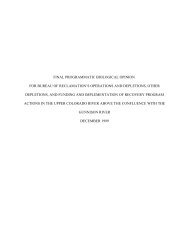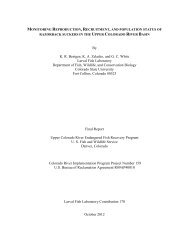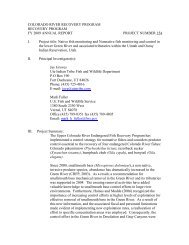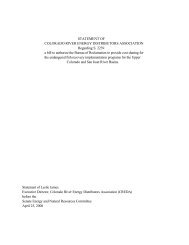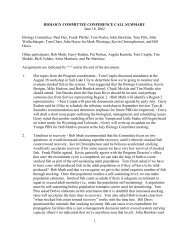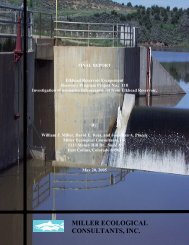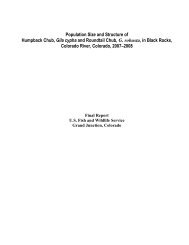riprap - Upper Colorado River Endangered Fish Recovery Program
riprap - Upper Colorado River Endangered Fish Recovery Program
riprap - Upper Colorado River Endangered Fish Recovery Program
Create successful ePaper yourself
Turn your PDF publications into a flip-book with our unique Google optimized e-Paper software.
2.1 I. IDENTIFY AND PROTECT INSTREAM FLOWS<strong>Recovery</strong> cannot be accomplished without securing, protecting, and managing sufficienthabitat to support self-sustaining populations of the endangered fishes. Identificationand protection of instream flows are key elements in this process. The first step ininstream-flow protection is to identify flow regimes needed by the fish. In the <strong>Recovery</strong><strong>Program</strong>, determining flow needs is primarily the responsibility of the Service (incooperation with other participants). Factors considered in determining flow needsinclude: flow effects on reproduction and recruitment; flow effects on food supplies andnonnative fishes; and interrelationships between flow and other habitat parametersbelieved to be important for the fish, such as channel structure, sediment transport,substrate characteristics, vegetative encroachment, and water temperature. Flowrecommendations often are made in stages, with initial flow recommendations based onthe best available scientific information, historic conditions, and extrapolation fromsimilar reaches. Recommendations then are refined following additional field research.The contribution of tributaries to recovery was ranked by Tyus and Saunders (2001). Astrategic plan was completed in 2003 that identified geomorphology research prioritiesto refine the flow recommendations and address the <strong>Recovery</strong> Goals (LaGory et al.2003). In 2012, USGS will publish results of a sediment transport study on threelocations in the upper <strong>Colorado</strong> <strong>River</strong> basin (<strong>Colorado</strong> <strong>River</strong> at Cameo, Gunnison <strong>River</strong>at Grand Junction, and Green <strong>River</strong> at Jensen). These results will help the <strong>Recovery</strong><strong>Program</strong> understand how flow recommendations may be benefitting recovery of theendangered fishes. A team of experts is being assembled to review the findings anddetermine whether the current flow recommendations need to be adjusted or additionaldata are needed.Flow recommendations have been approved for reaches of the <strong>Colorado</strong> (Osmundsonand Kaeding 1991; McAda 2003), Yampa (Modde and Smith 1995; Modde et al. 1999),Green (Muth et al. 2000), Gunnison (McAda 2003), and Duchesne (Modde and Keleher2003) rivers. Flows in the Little Snake <strong>River</strong> after estimated future depletions wereidentified in the Yampa <strong>River</strong> Management Plan and Environmental Assessment(Roehm 2004). Interim flow recommendations for the White <strong>River</strong> were completed in2004 (Irving et al. 2004), were reviewed in 2011, and will be revised in 2012. Flowrecommendations for the <strong>Colorado</strong> <strong>River</strong> below the Green <strong>River</strong> are pendingcompletion of the Aspinall Unit EIS. Flow recommendations for other rivers or riverreaches will be developed as deemed necessary to achieve recovery.In 2011, the Service and The Nature Conservancy formatted the <strong>Recovery</strong> <strong>Program</strong>'sflow recommendations and three National Wildlife Refuge water rights for inclusion asnon-consumptive water needs in the <strong>Colorado</strong> <strong>River</strong> Basin Water Supply and DemandStudy conducted by the Bureau of Reclamation. The study encompasses all seven<strong>Colorado</strong> <strong>River</strong> Basin States. It looks at current and future imbalances in water supplyand demand in the basin and adjacent areas through 2060 including projected effectsassociated with climate change and attempts to develop and analyze options and5



